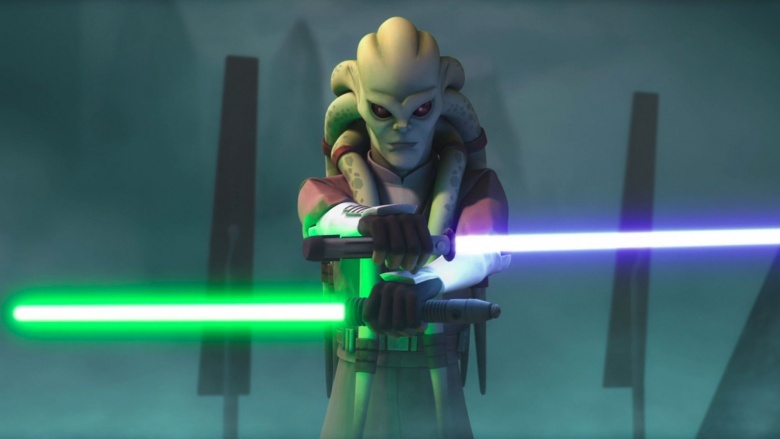When I held a snap poll for the martial art most people wanted for their own space knight, the Simple Form won not only the Non-Maradonian styles, but proved the most popular style overall, handily winning the poll. This quite surprised me, as it was the newest of the styles, created in Iteration 6, exclusively for the Templars, who remain the main people who will use it.
With the Simple Form, I wanted to explore two major ideas. First, if we're going to have people learning multiple styles and integrating them together, I wanted a style that really exploited that. In that regard, I created Infinite Stance Mastery, which allows the character one "free" 5-point move from any style. Incidentally, this works much better in the power-up form, because you can just go pluck an existing 5-point move, rather than designing them yourself. Second, I wanted to reward players for exploring multiple styles. Originally, I gave them a "Style Mastery" perk, which let them upgrade their Style Familiarity from allowing them to ignore -1 in Deceptive Attack or Feint penalties to a full, outright +1 to defense. I had intended to give them a universal version of this, so they gained it with any style they had style familiarity, but I found myself thinking "They'd literally be better off with Enhanced Parry (Force Sword), or Higher Purpose. Hey! Not a bad idea!"
For the rest of the style, I had a couple of problems. First, most moves are built on a single trademark move and then whatever techniques required to make it work. But the Simple Form doesn't really teach techniques other than Feint. The whole point of its original trademark moves were to codify pretty standard tactics, like the basic attack, or the basic parry. I see the Simple Form as taking what new players to GURPS typically do ("I attack. I parry. I feint. Then I attack with everything I can.") and making them better at it. So, the only way I could do that in a move was by collecting all of them, and thus First Steps was born. Then I wanted to make them good at fighting in general. I pondered what most players generally did in addition to the basic moves (retreats, extra-effort, etc) and made those better in the style. Finally, I rounded it out with a few Judo tricks. One concept I still like, but didn't fully emphasize here, was something similar to the Fell Form's approach to Karate, only with Judo. Judo can, after all, parry armed attacks, so a character with Judo 20 is as good at defending themselves from Force Sword attacks as someone with Force Sword 20 (technically better, because they gain the +3 retreat bonus even without Chambara rules). I added the Warding Parry to answer questions as to whether you can parry a force sword with an unarmed skill (from what I can see, it's perfectly permissible, but some people might have some doubts, so, you can do it with a -1).
This is the bit where I explain that this might have drawn loose inspiration from a Star Wars ligthsaber form and then point out which one, but in this case, I was explicitly inspired by Form I, or Shii-Cho, especially their discussion about how most Jedi don't take it seriously, but people who master it tend to be extremely flexible and effective. Like all other lightsaber forms, you don't really see this in the fiction; even Kit Fisto, who is supposed to be a true master of it, doesn't seem to fight in a particularly distinct way, and doesn't seem especially impressive in any of his video-game outings. Nonetheless, I wanted to explore the idea of a force sword form that seemed unimpressive at first, something only worthwhile to students, but really profited those who invested deeply in it.
"I guess people really want Wuxia in space." --Nemoricus
The other major inspiration, natural from its description and other inspirations, are Chinese martial arts and the traditions around them. If the Serene Form is the epitome of Japanese swordsmanship, then the Simple Form is the epitome of Chinese Swordsmanship. My experience with many Chinese styles is that where Japanese martial arts often focus on perfecting a single move or a single tactic, Chinese martial arts tend to focus on the fighter in a holistic manner. This is where these "Miyagi"-style traditions of putting a martial artist through lots of training that seems to have nothing to do with fighting comes from. We get concepts like "Internal martial arts" from this approach: improving the fighter's core, endurance and "chi" and only then teaching them to express it through their "external" martial arts, or their actual combat techniques. This likely means people will ask if they can use some of these moves with other martial arts precisely because they're so broadly applicable, and I think the idea is valid, though I'm not sure if I'll migrate them to other, non-force sword styles n exactly these forms (the Simple Form needs to maintain some sort of niche, after all).
Given that it's evidently the most popular style, I hope those who came to love it back in Iteration 6 still love it in its Iteration 7 incarnation.

No comments:
Post a Comment
Note: Only a member of this blog may post a comment.